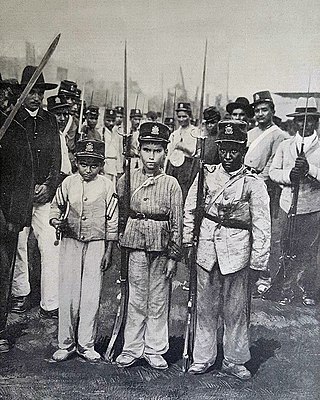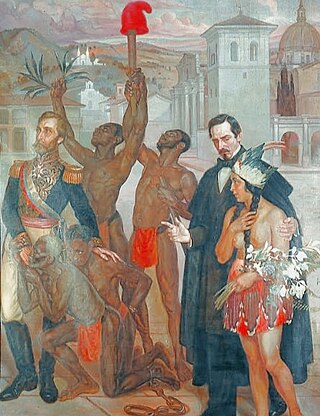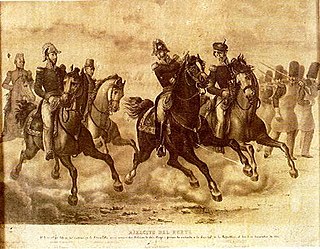
Panama, officially the Republic of Panama, is a country in Latin America at the southern end of Central America, bordering South America. It is bordered by Costa Rica to the west, Colombia to the southeast, the Caribbean Sea to the north, and the Pacific Ocean to the south. Its capital and largest city is Panama City, whose metropolitan area is home to nearly half the country's over 4 million inhabitants.

The history of Panama includes the history of the Isthmus of Panama prior to European colonization.

The flag of Panama was made by María de la Ossa de Amador and was officially adopted by the "ley 48 de 1925". The Panamanian flag day is celebrated on November 4, one day after Panamanian separation from Colombia, and is one of a series of holidays celebrated in November known as the Fiestas Patrias.

Manuel Amador Guerrero, was the first president of Panama from 20 February 1904 to 1 October 1908. He was a member of the Conservative Party.

Penonomé is the capital of the Panamanian province of Coclé. The town is located in the geographic center of Panama along the Inter-American Highway in the wide, flat lowlands of central Coclé.

Belisario Porras Barahona was a Panamanian journalist and politician. He served three terms as President of Panama between 1912 and 1924.

José Domingo de Obaldía Gallegos was President of Panama from October 1, 1908 to March 1, 1910.

Francisco Malespín Herrera was a Salvadoran military officer and politician, elected as the president of El Salvador in 1844. He served from 7 February 1844 to 15 February 1845, when he was deposed by his vice president Joaquín Eufrasio Guzmán after invading and overthrowing the liberal government in Nicaraguan. He also led El Salvador to a short unsuccessful war against Guatemala. After being deposed, Malespin returned to El Salvador with forces from Honduras, but he was captured and assassinated. Some of Malespin's closest allies were Francisco Ferrera in Honduras as well as Juan Lindo, both conservatives. He was supported by Honduras after his downfall.

La Violencia was a ten-year civil war in Colombia from 1948 to 1958, between the Colombian Conservative Party and the Colombian Liberal Party, fought mainly in the countryside.

The Thousand Days' War was a civil war fought in Colombia from 17 October 1899 to 21 November 1902, at first between the Liberal Party and the government led by the National Party, and later – after the Conservative Party had ousted the National Party – between the liberals and the conservative government. Caused by the longstanding ideological tug-of-war of federalism versus centralism between the liberals, conservatives, and nationalists of Colombia following the implementation of the Constitution of 1886 and the political process known as the Regeneración, tensions ran high after the presidential election of 1898, and on 17 October 1899, official insurrection against the national government was announced by members of the Liberal Party in the Department of Santander. Hostilities did not begin until the 11th of November, when liberal factions attempted to take over the city of Bucaramanga, leading to active warfare. It would end three years later with the signing of the Treaty of Neerlandia and the Treaty of Wisconsin. The war resulted in a Conservative victory, and ensured the continued dominance of the Conservative Party in Colombian politics for another 28 years. Colombia's political structure as a unitary state has not been challenged since.

The Battle of Aguadulce took place during the Colombian Thousand Days War, between Liberals and Conservatives. It occurred between February 23 and August 27, 1901 and ended in an overwhelming victory on the part of the Liberal army under the command of General Benjamin Herrera over the Conservative army based in the city of Aguadulce under the command of General Francisco Castro.

The Panama Defense Forces (Spanish: Fuerzas de Defensa de Panamá; FFDD) formerly the National Guard (of Panama) (Spanish: Guardia Nacional), were the armed forces of the Republic of Panama.

José María Dionisio Melo y Ortiz was a Colombian general and political figure who fought in the South American wars of independence, and who rose to power and briefly held the presidency of Colombia in 1854. Of Pijao ancestry, he is considered the country's first and only indigenous president.

The separation of Panama from Colombia was formalized on 3 November 1903, with the establishment of the Republic of Panama. From the Independence of Panama from Spain in 1821, Panama had simultaneously declared independence from Spain and joined itself to the confederation of Gran Colombia through the Independence Act of Panama. Panama was always tenuously connected to the rest of the country to the south, owing to its remoteness from the government in Bogotá and lack of a practical overland connection to the rest of Gran Colombia. In 1840–41, a short-lived independent republic was established under Tomás de Herrera. After rejoining Colombia following a 13-month independence, it remained a province which saw frequent rebellious flare-ups, notably the Panama crisis of 1885, which saw the intervention of the United States Navy, and a reaction by the Chilean Navy.

Carlos Eugenio Restrepo Restrepo was a Colombian lawyer, writer, and statesman, who was elected President of Colombia in 1910. During his administration he worked towards making political reconciliation among the Conservative and Liberals. He appointed members of the Liberal Party to his Cabinet, and to the dismay of some of his own party, adopted a neutral stand on all issues. He later served as Minister of Government and Ambassador to the Vatican City State.

The following is an alphabetical list of topics related to the Republic of Panamá.
Events in the year 1901 in Colombia.

The Battle of Peralonso, also known as the Battle of La Amarilla or the Battle of La Laja, was a major battle in the Santander Campaign of the Thousand Days' War in Colombia. It was fought between the Conservative government and the Liberal rebels between 15 and 16 December 1899, ending in an important Liberal victory. The Liberal rebels had suffered a series of major defeats culminating in the failed attack on Bucaramanga on 13 November. Afterward, the Liberal forces splintered into three autonomous forces, led by Rafael Uribe Uribe, Benjamín Herrera, and Justo L. Durán, but they first regrouped in Cúcuta. The autonomous rebel armies shifted to new positions on and around the heights of Cerro Tasajero, north of Cúcuta and close to the border with Venezuela.

The Colombian Civil War of 1851 was a Civil War in the Republic of New Granada between Liberals and Conservatives, fought between May and September 1851. The cause for the war was the Abolition of Slavery. The war was won by the Liberals.

The Colombian Civil War of 1854 was a civil conflict that took place in the Republic of New Granada. It was the popular response supported by both Liberals and Conservatives against the coup d'état orchestrated by General José María Melo on 17 April 1854.



















